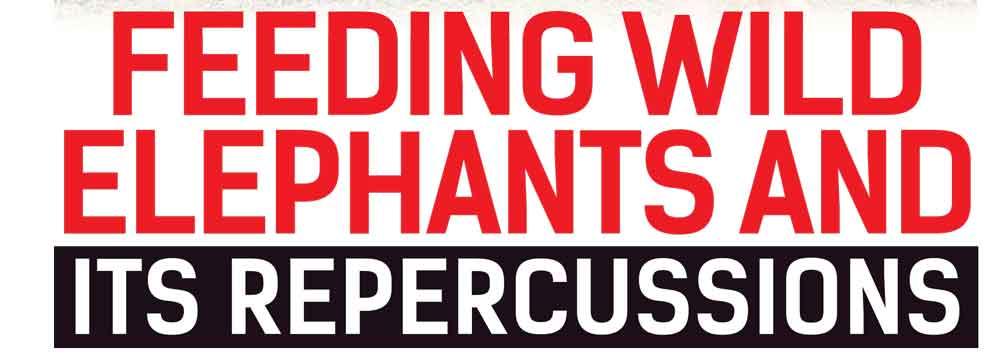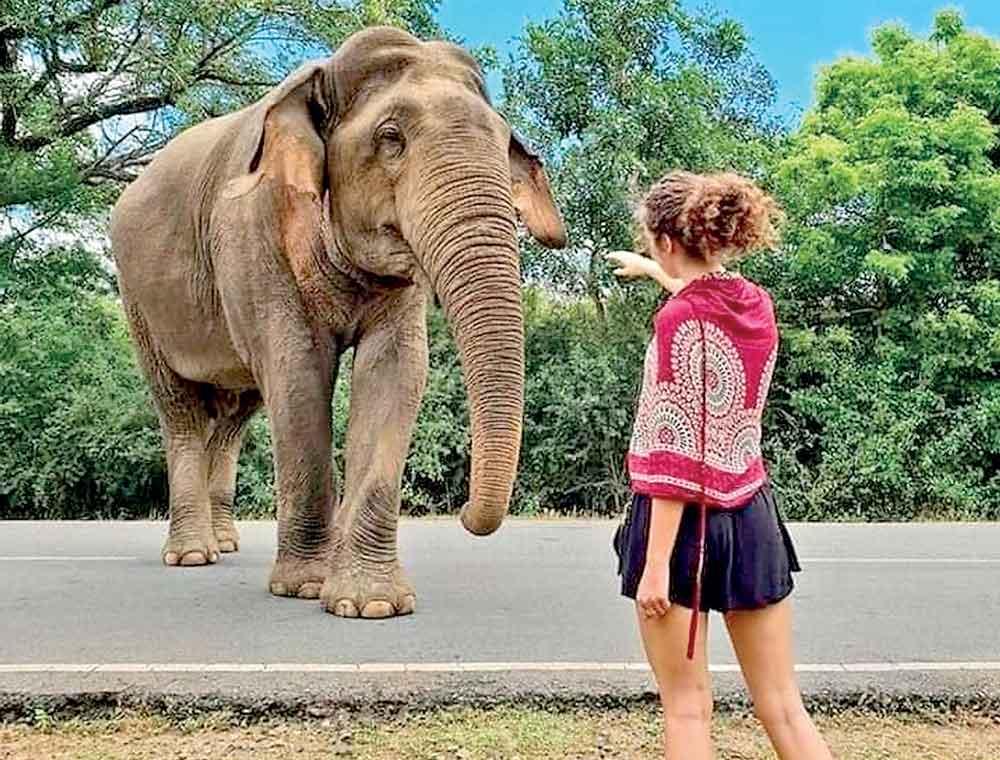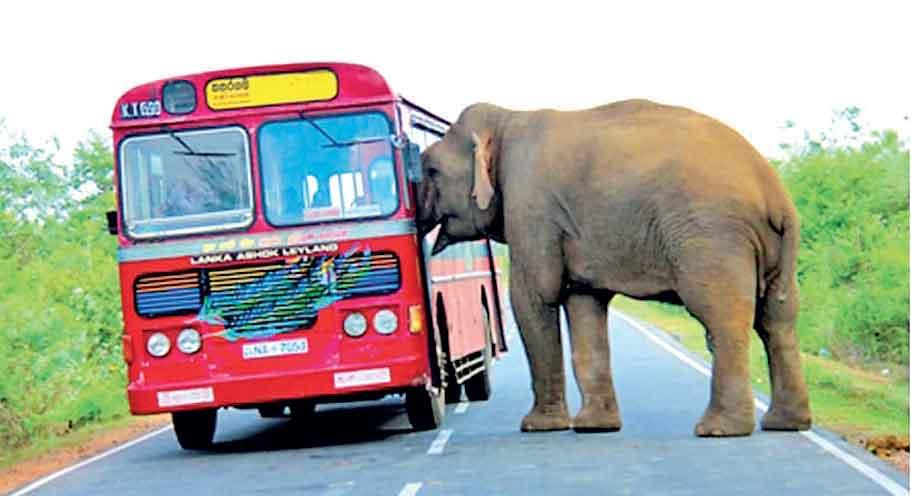Reply To:
Name - Reply Comment

| Spotlight on Kataragama- Buttala highway |

The questionable practice of feeding wild elephants has resulted in the habit of jumbos standing alongside the road and obstructing vehicles from moving until they are fed
Groups of pilgrims and tourists, motoring through national parks, are in the habit of feeding and petting wild animals at the peril of their own lives
The situation has become so aggravated that the wild elephants await vehicles in the hope of being fed
People opine that they prefer to approach wild elephants and pet them rather than watch elephants in captivity
Feeding of wild elephants is a common occurrence on the Buttala-Kataragama Road and in areas like Dambula, Habarana, Polonnaruwa and Udawalawa
 Feeding of wild elephants that frequent the roadside near national parks and forest reserves, regardless of its dangers, has been going on unchecked for a long time, much to the concern of the wildlife authorities.
Feeding of wild elephants that frequent the roadside near national parks and forest reserves, regardless of its dangers, has been going on unchecked for a long time, much to the concern of the wildlife authorities.
Groups of pilgrims and tourists, motoring through national parks, are in the habit of feeding and petting wild animals at the peril of their own lives. This is despite warnings by the wildlife authorities to refrain from such risky undertakings.
 The situation has become so aggravated that the wild elephants await vehicles in the hope of being fed. These animals attack people if attempts are made to ignore them and pass the area. A couple of weeks ago a woman died when a jumbo frequenting the Kataragama- Buttala highway-which runs through Yala National Park- overturned a lorry carrying a group of pilgrims. They had fed the jumbo with a comb of bananas and kept on watching. The jumbo had put its trunk into the lorry after gulping down the comb of bananas indicating to be fed more. The animal had hit the lorry which attempted to speed away. The woman occupying the front seat fell off the vehicle and was pinned under the lorry. The lorry earlier toppled due to the aggressive actions of the elephant.
The situation has become so aggravated that the wild elephants await vehicles in the hope of being fed. These animals attack people if attempts are made to ignore them and pass the area. A couple of weeks ago a woman died when a jumbo frequenting the Kataragama- Buttala highway-which runs through Yala National Park- overturned a lorry carrying a group of pilgrims. They had fed the jumbo with a comb of bananas and kept on watching. The jumbo had put its trunk into the lorry after gulping down the comb of bananas indicating to be fed more. The animal had hit the lorry which attempted to speed away. The woman occupying the front seat fell off the vehicle and was pinned under the lorry. The lorry earlier toppled due to the aggressive actions of the elephant.
It is reported that obstructions are caused to vehicles by wild elephants who now have the habit of waiting for food from travelers. These activities can be witnessed in the Digampathana and Dambulla areas.
People are under the impression that they have the opportunity to approach the wild elephants in their natural habitat and pet them rather than watching them in captivity in the zoo. However this act of feeding wild beasts, akin to feeding domesticated animals, demands much courage.

 There were expectations of formulating a long-term policy to guarantee the survival of wild elephants, prevent the human – elephant conflict, harness the economic benefits of conserving wild elephants, provide relief to people affected by the human-elephant conflict, and remove elephants from forests to meet the requirement of managing the elephant population. However, the plan has been brushed under the carpet
There were expectations of formulating a long-term policy to guarantee the survival of wild elephants, prevent the human – elephant conflict, harness the economic benefits of conserving wild elephants, provide relief to people affected by the human-elephant conflict, and remove elephants from forests to meet the requirement of managing the elephant population. However, the plan has been brushed under the carpet
- Saminda Vidanage (Environmentalist)
Feeding of wild elephants is a common occurrence on the Buttala-Kataragama Road and in areas like Dambula, Habarana, Polonnaruwa and Udawalawa.
This questionable practice has resulted in the habit of jumbos standing astride the roads and obstructing vehicles from moving until they receive food. Quite often vehicles have come under the attack of wild elephants. These animals have the habit of bumping against vehicles. The incident faced by a group of pilgrims travelling on the Kataragama- Buttala road on December 12 that caused the death of a woman was one such occasion.
Animal lovers and environmentalists have used social media to highlight the dangers faced by travelers and elephants while on these roads.
Wild elephants travel long distances; sometimes moving as much as 20 kilo metres or more each day in search of food and water. Elephants need between 159 and 200 kilos of fodder a day. However the number of wild elephants waiting by the lonely roads and depending on people for food has been increasing. However the food meant for people could turn out to be poison for these animals. Feeding wild elephants, just for pleasure could result in health issues affecting them. Added to it is the danger facing the people, who get too close to the wild elephants to pet them.
Environmentalist Saminda Vidanage said the Department of Wildlife Conservation had taken step to consult the views of the public on formulating a national policy on conservation and the management of wild elephants.
“There were expectations of formulating a long-term policy to guarantee the survival of wild elephants, prevent the human – elephant conflict, harness the economic benefits of conserving wild elephants, provide relief to people affected by the human-elephant conflict, and remove elephants from forests to meet the requirement of managing the elephant population. However, the plan has been brushed under the carpet.

“The Torque monkey menace has been aggravating just as the threat of wild elephants. People are inclined to kill them as their last resort to resolve the issue. However, the people are normally animal lovers, yet they would not hesitate to destroy the animals unless the authorities work out an effective mechanism to create an atmosphere for the man and the animal to live freely in their respective habitats. It is imperative that development should not take place at the expense of destroying natural habitats of the wild animals. These are places where animals have a right to live and breed freely,” said Vidanage.
However if the wild elephants waiting for food by the roadsides, obstruct the vehicles that are passing until they were fed, it is the duty of officials of the Department of Wildlife Conservation to put an end to such practices.